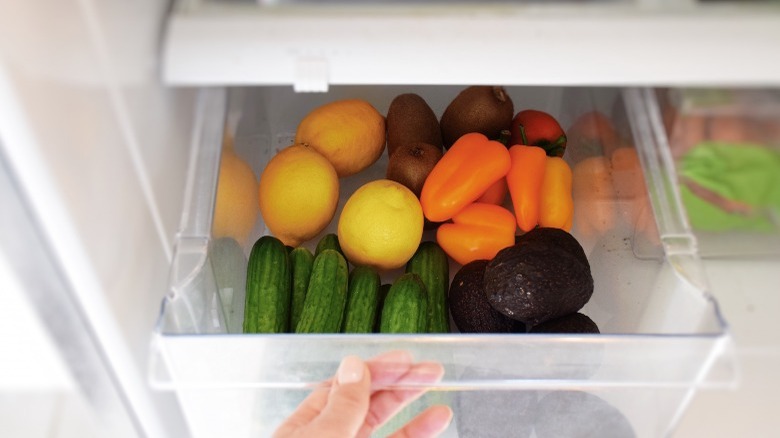You Shouldn't Store Produce In The Refrigerator Door. Here's Why
When it comes to storing food, most of us probably take that handy kitchen appliance, the refrigerator, for granted. But when you really stop and think about it, this appliance — now found in nearly 100% of American homes, according to CNN — has truly revolutionized the way we eat since it became available for home use starting in the late 1920s (via Apartment Therapy). Far from having to worry about root cellars or even canning and preserving, most of us, these days, can make big shopping runs and chuck everything into the refrigerator without having to strategize how to keep the food from going bad.
And although the basic premise of a fridge — it circulates cold air around foods, in order to extend their shelf life, per Whirlpool Canada — is pretty simple to understand, most of us could definitely be smarter about how we store our food inside it. Did you know, for example, that there's a whole strategy to where certain items should be stashed, depending on the food and the temperature and humidity level of each area of your fridge (via Delish)? And according to those guidelines, you don't want to store produce in the refrigerator door.
The fridge door is subject to temperature fluctuations
When most of us get home from a big grocery store trip, we most likely just unload our perishable foods into the fridge without thinking, pushing and shoving them into the crevices where there's room. But this is actually not the smartest way to stock a fridge: According to Delish, raw meat and fish should go on the bottom shelf, for example, so that their juices won't drip onto other foods below them, and cooked food should go on the top shelf as any leaks won't be a food safety hazard.
According to this same logic, produce such as fruits and vegetables should not be tucked into your fridge door, per EatingWell. As the outlet explains, this door — which, after all, swings open and closed throughout the day — will experience the most change in temperature as cool air is let out and warm ambient air comes in. Since fruits and vegetables are highly perishable, this isn't a good spot for them, where warm air might cause them to dry out or wither.
Instead, Taste of Home recommends placing fruits and vegetables in your refrigerator's bottom crisper drawer, which is designed specifically for produce and which often even allows you to control the humidity in addition to the temperature. When it comes to the refrigerator door, stick to stable items such as condiments, jams, and salad dressings.

